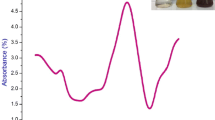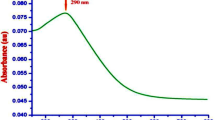Abstract
The present study was carried out to establish the biofabrication of palladium nanoparticles (PdNPs) using the plant leaf extract of Tinospora cordifolia Miers and its toxicity studies on the larvae of filariasis vector, Culex quinquefasciatus Say and malaria vector, Anopheles subpictus Grassi. The biofabricated PdNPs were characterized by using UV–visible spectrum, FTIR, XRD, FESEM, EDX and HRTEM. HRTEM confirmed the PdNPs were slightly agglomerated and spherical in shape and the average size was 16 nm. Gas chromatography and mass spectrometry analysis result revealed that the major constituent present in the T. cordifolia leaf extract is 2,4-di-tert-butylphenol (31.79%) whereas the minor compounds are 1-hexadecanol (7.97%), 1-octadecanol (7.70%), 1-eicosanol (6.85%), behenic alcohol (5.36%), 1-tetradecene (6.22%), cyclotetradecane (6.23%), 1-hexadecene (7.97%), 1-octadecene (7.70%), 1-eicosene (6.85%), and 1-docosene (5.36%). T. cordifolia leaf extract exhibited the larvicidal activity against the fourth instar larvae of C. quinquefasciatus and A. subpictus with the values of LC50 = 59.857 and 54.536 mg/L; LC90 = 113.445 and 108.940 mg/L, respectively. The highest toxicity was observed in the biofabricated PdNPs against the fourth instar larvae of C. quinquefasciatus and A. subpictus with the values of LC50 = 6.090 and 6.454 mg/L; LC90 = 13.689 and 13.849 mg/L, respectively. Concerning non-target effects, Poecilia reticulata were exposed to PdNPs for 24 h and did not exhibit any noticeable toxicity. Overall, our findings strongly suggest that PdNPs is a perfect ecological and inexpensive approach for the control of filariasis and malaria vectors.






Similar content being viewed by others
References
Abbott WS (1925) A method of computing the effectiveness of an insecticide. J Econ Entomol 18:265–267
Bankar A, Joshi B, Kumar AR, Zinjarde S (2010) Banana peel extract mediated novel route for the synthesis of palladium nanoparticles. Mater Lett 64(18):1951–1953
Benelli G (2015) Research in mosquito control: current challenges for a brighter future. Parasitol Res 114(8):2801–2805
Benelli G, Govindarajan M (2016) Green-synthesized mosquito oviposition attractants and ovicides: towards a nanoparticle-based “lure and kill” approach? J Clust Sci 28(1):287–308
Birkholz M, Fewster PF, Genzel C (2006) Thin film analysis by X-ray scattering. Wiley-VCH, New York
Biswal S, Sahoo J, Murthy PN (2009) Physicochemical properties of solid dispersions of gliclazide in polyvinylpyrrolidone K90. AAPS Pharm Sci Tech 10(2):329–334
Black RE, Cousens S, Johnson HL, Lawn JE, Rudan I, Bassani DG, Jha P, Campbell H, Walker CF, Cibulskis R, Eisele T, Liu L, Mathers C (2010) Global, regional, and national causes of child mortality in 2008: a systematic analysis. Lancet 375(9730):1969–1987
Cadavid-Restrepo G, Sahaza J, Orduz S (2012) Treatment of an Aedes aegypti colony with the Cry11Aa toxin for 54 generations results in the development of resistance. Mem Inst Oswaldo Cruz 107:74–79
Cha JH, Kim KS, Choi S, Yeon SH, Lee H, Lee CS, Shim JJ (2007) Size-controlled electrochemical synthesis of palladium nanoparticles using morpholinium ionic liquid. Korean J Chem Eng 24(6):1089–1094
Chandra G, Bhattacharjee I, Chatterjee S (2010) A review on Anopheles subpictus Grassi—a biological vector. Acta Trop 15(2):142–154
Chenniappan K, Ayyadurai N (2012) Synergistic activity of Cyt1A from Bacillus thuringiensis subsp. israelensis with Bacillus sphaericus B101 H5a5b against Bacillus sphaericus B101 H5a5b-resistant strains of Anopheles stephensi Liston (Diptera: Culicidae). Parasitol Res 110:381–388
Elango G, Rahuman AA, Bagavan A, Kamaraj C, Zahir AA, Rajakumar G, Marimuthu S, Santhoshkumar T (2010) Studies on effects of indigenous plant extracts on malarial vector, Anopheles subpictus Grassi (Diptera: Culicidae). Trop Biomed 27(2):143–154
Finney DJ (1971) Probit analysis, 3rd edn. Cambridge University Press, Cambridge (ISBN 052108041X. OCLC 174198382)
Gandhi PR, Jayaseelan C, Vimalkumar E, Mary RR (2016) Larvicidal and pediculicidal activity of synthesized TiO2 nanoparticles using Vitex negundo leaf extract against blood feeding parasites. J Asia Pac Entomol 19(4):1089–1094
Govindarajan M, Benelli G (2016) A facile one-pot synthesis of eco-friendly nanoparticles using Carissa carandas: ovicidal and larvicidal potential on malaria, dengue and filariasis mosquito vectors. J Clust Sci 28(1):15–36
Ingle A, Gade A, Pierrat S, Sonnichsen C, Rai M (2008) Mycosynthesis of silver nanoparticles using the fungus Fusarium acuminatum and its activity against some human pathogenic bacteria. Curr Nanosci 4(2):141–144
Jayaseelan C, Rahuman AA, Rajakumar G, Kirthi AV, Santhoshkumar T, Marimuthu S, Bagavan A, Kamaraj C, Zahi AA, Elango G (2011) Synthesis of pediculocidal and larvicidal silver nanoparticles by leaf extract from heartleaf moonseed plant, Tinospora cordifolia Miers. Parasitol Res 109(1):185–194
Kamaraj C, Bagavan A, Rahuman AA, Zahir AA, Elango G, Pandiyan G (2009) Larvicidal potential of medicinal plant extracts against Anopheles subpictus Grassi and Culex tritaeniorhynchus Giles (Diptera: Culicidae). Parasitol Res 104(5):1163–1171
Khanam S, Mohan NP, Devi K, Sultana R (2011) Protective role of Tinospora cordifolia against cisplatin induced nephrotoxicity. Int J Pharm Pharm Sci 3(11):268–270
Kumar A, Shrivastav S (1995) A study of antipyretic effect of Guduchi. Sachitra Ayurveda 48:289–291
Kumari MM, Aromal SA, Philip D (2013) Synthesis of monodispersed palladium nanoparticles using tannic acid and its optical non-linearity. Spectrochim Acta A Mol Biomol Spectrosc 103:130–133
Mallikarjuna K, Sushma NJ, Reddy BS, Narasimha G, Raju BD (2013) Palladium nanoparticles: single-step plant-mediated green chemical procedure using Piper betle leaves broth and their anti-fungal studies. Int J Chem Anal Sci 4(1):14–18
Meyer JC, Kurasch S, Park HJ, Skakalova V, Künzel D, Gross A, Chuvilin A, Algara-Siller G, Roth S, Iwasaki T, Starke U, Smet JH, Kaiser U (2011) Experimental analysis of charge redistribution due to chemical bonding by high-resolution transmission electron microscopy. Nat Mater 10(3):209–215
Molaie R, Farhadi K, Forough M, Emamali RS (2012) Biological and green synthesis of palladium nanoparticles using aqueous extract of Pistacia atlantica plant’s fruit: a facile biological approach. Proceedings of the 4th International Conference on Nanostructures (ICNS4) 12–14 March, Kish Island, I.R. Iran
Murugan K, Nataraj D, Jaganathan A, Dinesh D, Jayashanthini S, Samidoss CM, Paulpandi M, Panneerselvam C, Subramaniam J, Nicoletti M, Kumar S (2016) Nanofabrication of graphene quantum dots with high toxicity against malaria mosquitoes, Plasmodium falciparum and MCF-7 cancer cells: impact on predation of non-target tadpoles, odonate nymphs and mosquito fishes. J Clust Sci 28(1):393–411
Nadagouda MN, Varma RS (2008) Green synthesis of silver and palladium nanoparticles at room temperature using coffee and tea extract. Green Chem 10(8):859–862
Narayanan R, El-Sayed MA (2005) Catalysis with transition metal nanoparticles in colloidal solution: nanoparticle shape dependence and stability. J Phys Chem B 109(26):12663–12676
Nayampalli S, Ainapure SS, Nadkarni PM (1982) Study of antiallergic acid bronchodilator effects of Tinospora cordifolia. Indian J Pharm 14:64–66
Nayampalli SS, Desai NK, Ainapure SS (1986) Anti-allergic properties of Tinospora cordifolia in animal models. Indian J Pharmacol 18(4):250–252
Nemamcha A, Rehspringer JL, Khatmi D (2006) Synthesis of palladium nanoparticles by sonochemical reduction of palladium(II) nitrate in aqueous solution. J Phys Chem B 110(1):383–387
Newbury DE, Ritchie NW (2013) Is scanning electron microscopy/energy dispersive X-ray spectrometry (SEM/EDS) quantitative? Scanning 35(3):141–168
Nguyen PM, Kwee EM, Niemeyer ED (2010) Potassium rate alters the antioxidant capacity and phenolic concentration of basil (Ocimum basilicum L) leaves. Food Chem 123(4):1235–1241
Panchabhai T, Ambarkhane S, Joshi A, Samant B, Rege N (2008) Protective effect of Tinospora cordifolia, Phyllanthus emblica and their combination against antitubercular drugs induced hepatic damage: an experimental study. Phytother Res 22(5):646–650
Patil CD, Patil SV, Borase HP, Salunke BK, Salunkhe RB (2012) Larvicidal activity of silver nanoparticles synthesized using Plumeria rubra plant latex against Aedes aegypti and Anopheles stephensi. Parasitol Res 110(5):1815–1822
Petla RK, Vivekanandhan S, Misra M, Mohanty AK, Satyanarayana N (2012) Soybean (Glycine max) leaf extract based green synthesis of palladium nanoparticles. J Biomater Nanobiotechnol 3:14–19
Ramanibai R, Velayutham K (2016) Synthesis of silver nanoparticles using 3, 5-di-t-butyl-4-hydroxyanisole from Cynodon dactylon against Aedes aegypti and Culex quinquefasciatus. J Asia Pac Entomol 19(3):603–609
Rao SK, Rao SP, Rao NB (2008) Preliminary investigation of the radiosensitizing activity of Guduchi (Tinospora cordifolia) in tumor bearing mice. Phytother Res 22(11):1482–1489
Rege NN, Dahanukar SA, Karandikar SM (1984) Hepatoprotective effects of Tinospora cordifolia against carbon tetrachloride induced liver damage. Indian Drugs 21:544–555
Sharma VK, Ria AY, Lin Y (2009) Silver nanoparticles: green synthesis and their antimicrobial activities. Adv Colloid Interf Sci 145(1):83–96
Sheny DS, Philip D, Mathew J (2012) Rapid green synthesis of palladium nanoparticles using the dried leaf of Anacardium occidentale. Spectrochim Acta A Mol Biomol Spectrosc 91:35–38
SPSS (2007) SPSS for windows, version 16.0. Release 16.0.0 (Chicago, IL, USA)
Suman TY, Rajasree SR, Jayaseelan C, Mary RR, Gayathri S, Aranganathan L, Remya RR (2016) GC-MS analysis of bioactive components and biosynthesis of silver nanoparticles using Hybanthus enneaspermus at room temperature evaluation of their stability and its larvicidal activity. Environ Sci Pollut Res 23(3):2705–2714
Wadood N, Wadood A, Shah SA (1992) Effect of Tinospora cordifolia on blood glucose and total lipid levels of normal and alloxan-diabetic rabbits. Planta Med 58(02):131–136
WHO (1996) Report of the WHO Informal Consultation on the Evaluation on the Testing of Insecticides (CTD/WHO PES/IC/96. 1, 69)
WHO (2010) Working to overcome the global impact of neglected tropical diseases: first WHO report on neglected tropical diseases. No1, 2010
WHO (2014) Lymphatic filariasis. Fact sheet no. World Health Organization, Geneva, p 102
Xiong Y, Chen J, Wiley B, Xia Y (2005) Understanding the role of oxidative etching in the polyol synthesis of Pd nanoparticles with uniform shape and size. J Am Chem Soc 127(20):7332–7333
Yang X, Li Q, Wang H, Huang J, Lin L, Wang W, Sun D, Su Y, Opiyo JB, Hong L, Wang Y, He N, Jia L (2010) Green synthesis of palladium nanoparticles using broth of Cinnamomum Camphora leaf. J Nanopart Res 12(5):1589–1598
Zhao TF, Wang X, Rimando AM, Che C (1991) Folkloric medicinal plants: Tinospora Sagittata var. cravaniana and Mahonia bealei. Planta Med 57(05):505
Acknowledgements
The authors are grateful to the Management of Sathyabama University, Chennai, and Auxilium College (Autonomous), Vellore, for providing the facilities to carry out this work. We acknowledge the support extended by Cochin University of Science and Technology, Cochin, in analyzing the samples by XRD and FTIR. The authors also acknowledge the FESEM support provided by Pukyong National University, South Korea, to carry out this work. The authors acknowledge the Science and Engineering Research Board (SERB), Department of Science and Technology, New Delhi, India, for the award of the National Postdoctoral fellowship program (PDF/2016/000942).
Author information
Authors and Affiliations
Corresponding authors
Additional information
Responsible editor: Philippe Garrigues
Rights and permissions
About this article
Cite this article
Jayaseelan, C., Gandhi, P.R., Rajasree, S.R.R. et al. Toxicity studies of nanofabricated palladium against filariasis and malaria vectors. Environ Sci Pollut Res 25, 324–332 (2018). https://doi.org/10.1007/s11356-017-0428-x
Received:
Accepted:
Published:
Issue Date:
DOI: https://doi.org/10.1007/s11356-017-0428-x




